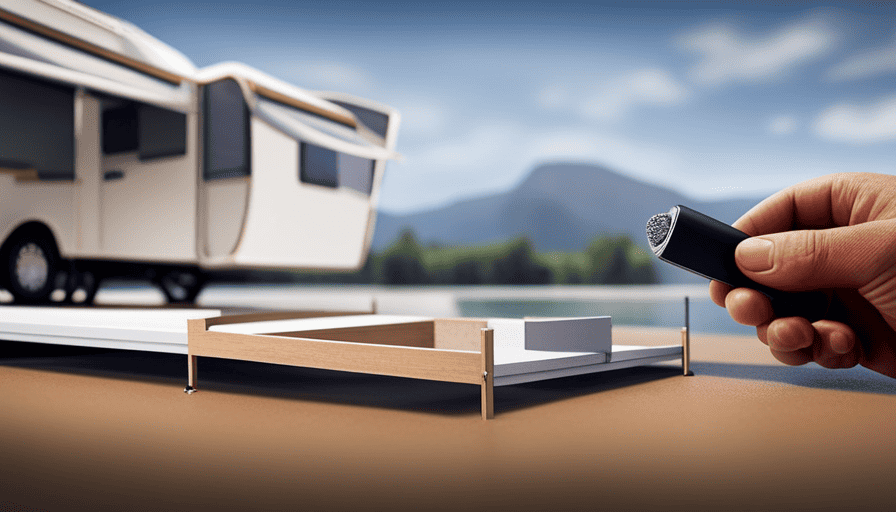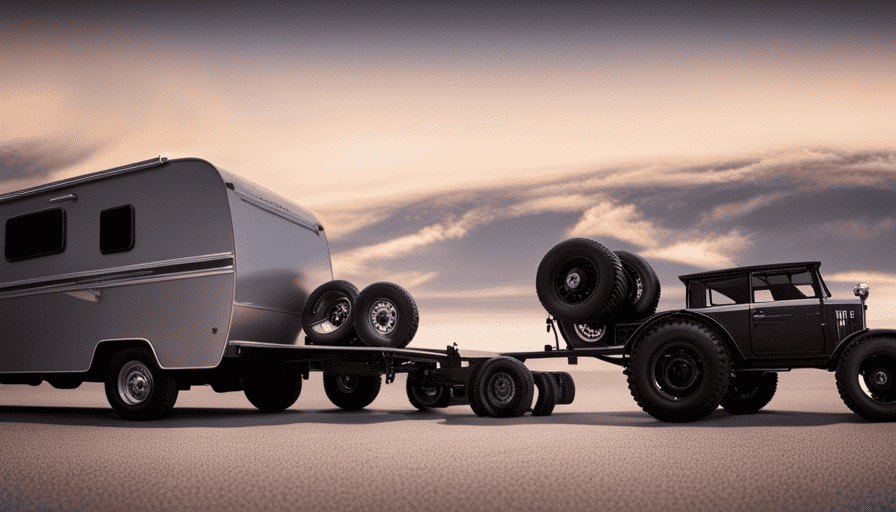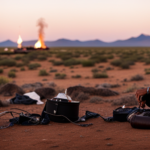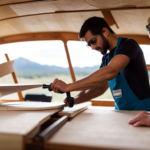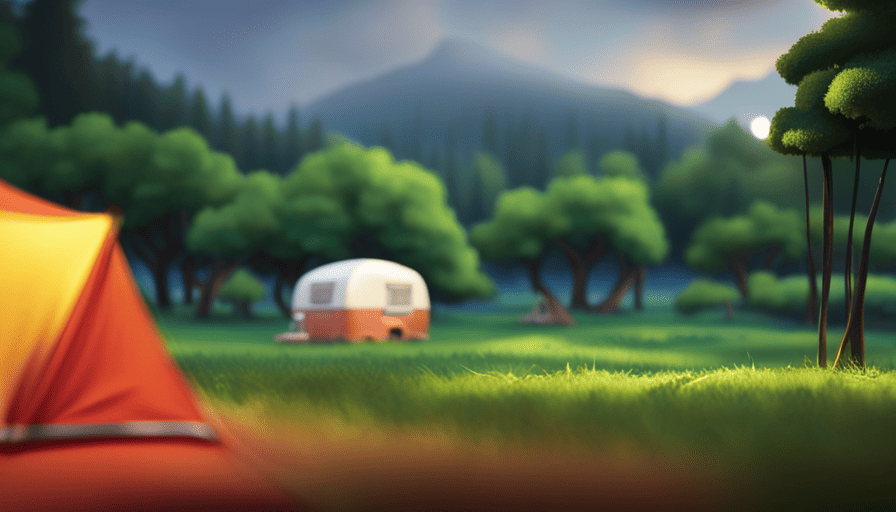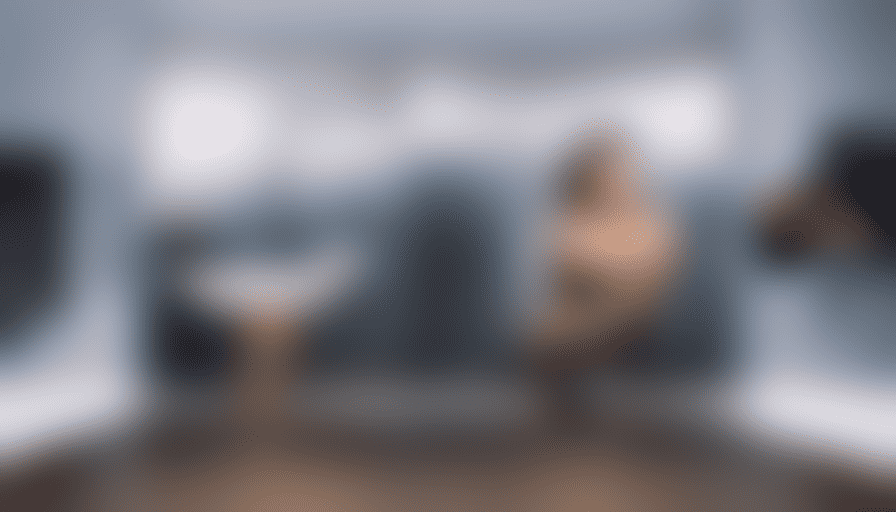I have always had a passion for nature and the sense of freedom that comes with traveling on the open road. It is truly invigorating to cruise down the highway with the wind in your hair and a spirit of adventure in your heart.
But let’s face it, camping can sometimes be a hassle. Tents are uncomfortable and RVs can be expensive. That’s why I decided to build my own pop-up camper, combining the best of both worlds. With a little bit of know-how and a lot of determination, I was able to create a home away from home that was both comfortable and affordable.
In this article, I’ll share with you my step-by-step guide on how to build your very own pop-up camper. So grab your tools, roll up your sleeves, and get ready to embark on your own DIY camping journey. Trust me, the end result will be worth every ounce of effort.
Let’s get started!
Key Takeaways
- Determine camping needs and budget before starting the construction of a pop-up camper.
- Choose lightweight and strong materials for the frame and reinforce joints and connections for stability.
- Strategically plan window placement for proper ventilation and natural light in different areas of the camper.
- Carefully plan the layout of the electrical and plumbing systems for safety and efficiency.
Determine Your Camping Needs and Budget
Now, let’s figure out what you need and how much you’re willing to spend on your dream pop-up camper.
Determining your camping essentials is crucial in building a camper that suits your needs. Consider the number of people who’ll be using the camper, the duration of your trips, and the type of camping you enjoy. Are you someone who loves to cook elaborate meals or do you prefer quick and easy camping meals? Do you need a bathroom or can you make do with campground facilities? These are important factors to consider when designing your camper.
Once you have a clear idea of your camping needs, it’s time to set a budget. Determine how much you can afford to spend on your project. Keep in mind that building a pop-up camper can be a costly endeavor, so it’s important to establish a realistic budget. Consider the cost of materials, tools, and any additional features you may want to incorporate.
With your camping essentials determined and your budget set, you can now move on to the next step of gathering the necessary tools and materials. This will ensure that you have everything you need to bring your dream pop-up camper to life.
Gather the Necessary Tools and Materials
First, you’ll need to gather all the essential tools and materials, so you can embark on this exciting adventure of creating your very own cozy home on wheels.
Choosing the right materials is crucial for building a sturdy and durable pop-up camper. Opt for lightweight yet strong materials like plywood for the frame, as it provides stability while being easy to work with. For the exterior, consider using fiberglass or aluminum, as they’re weather-resistant and offer excellent insulation.
Additionally, gather screws, nails, hinges, and other hardware to secure everything together.
Safety precautions during construction should also be a top priority. Make sure to wear protective gear such as safety goggles, gloves, and a dust mask to prevent any injuries. Take your time and double-check measurements to ensure accuracy and minimize mistakes.
It’s also important to work in a well-ventilated area to avoid inhaling harmful fumes from adhesives and paints.
With all the necessary tools and materials at hand, you’re now ready to design and plan your pop-up camper, turning your vision into a reality. Remember to consider your camping needs and budget as you move forward in this exciting DIY project.
Design and Plan Your Pop-Up Camper
Take a moment to envision your dream getaway on wheels, where cramped quarters and limited amenities are the epitome of luxury and relaxation. Designing and planning your own pop-up camper allows you to customize every aspect to meet your specific needs and desires. Before you start building, it’s important to consider some key factors that will influence the overall design.
First, think about the size and layout of your camper. Consider how many people will be using it and what activities you plan to do inside. This will help determine the number of beds, seating areas, and storage spaces you’ll need. Additionally, think about the weight and towing capacity of your vehicle, as this will affect the overall dimensions and materials used.
Next, consider any modifications you want to make to the basic pop-up camper design. This could include adding extra windows for more natural light, installing a pop-top roof for increased headroom, or incorporating a slide-out section for additional living space.
To help you visualize these design considerations, here is a table outlining some common modifications and their benefits:
| Modification | Benefits |
|---|---|
| Extra windows | More natural light and better ventilation |
| Pop-top roof | Increased headroom and a more spacious feel |
| Slide-out section | Additional living space for added comfort |
| Exterior awning | Shade and protection from the elements |
Now that you have a clear vision of your ideal pop-up camper, it’s time to move on to building the frame and flooring.
Build the Frame and Flooring
Get ready to construct the sturdy foundation of your ultimate adventure getaway on wheels by building the frame and flooring of your dream pop-up trailer. When it comes to building the frame and flooring, choosing the right materials is crucial. You want to ensure that they’re durable enough to withstand the bumps and vibrations of the road, while also being lightweight enough for easy towing.
Many DIY enthusiasts opt for materials like aluminum or steel for the frame, as they offer both strength and stability. For the flooring, marine-grade plywood is often the go-to choice, as it’s resistant to moisture and rot.
To ensure stability and durability, it’s important to pay attention to every detail during the construction process. Make sure to reinforce the joints and connections using sturdy bolts and screws. Additionally, consider adding extra bracing or crossbeams to provide additional support. Taking the time to properly construct the frame and flooring will not only ensure the safety of your pop-up camper, but also enhance its longevity.
Now that the frame and flooring are complete, it’s time to move on to the next step: installing the walls and roof. By carefully following the instructions and using the right tools, you’ll be one step closer to turning your vision into reality.
Install the Walls and Roof
Now it’s time to transform your bare frame into a cozy haven by installing the walls and roof, enveloping you in a sense of security and adventure all at once. The first step in this process is installing insulation to ensure that your pop up camper is well-insulated and comfortable in all weather conditions. This will help regulate the temperature inside and make your camping experience more enjoyable.
To install the walls, measure and cut the appropriate size of plywood panels that will fit snugly onto the frame. Attach these panels securely using screws or nails. Make sure to leave spaces for windows and doors if desired. Once the walls are in place, it’s time to install the roof. Measure and cut the plywood panels to fit the top of the frame. Secure them tightly using screws or nails, ensuring that they are aligned properly.
Now that the walls and roof are installed, it’s time to focus on the pop up mechanism. This mechanism allows the camper to be easily raised and lowered, providing convenience and functionality. Follow the manufacturer’s instructions carefully to ensure proper installation. This mechanism will make it effortless to set up and pack up your camper whenever you’re ready to hit the road.
With the walls, roof, and pop up mechanism in place, you’re one step closer to completing your pop up camper. In the next section, we’ll explore how to add windows, doors, and ventilation to make your camper even more comfortable and inviting.
Add Windows, Doors, and Ventilation
Imagine the feeling of fresh air gently caressing your face as you leisurely open the windows and doors of your cozy sanctuary, allowing the outside world to embrace you while maintaining a sense of security. When it comes to building a pop-up camper, adding windows, doors, and ventilation is a crucial step.
Proper ventilation options not only ensure a comfortable living space but also contribute to the overall well-being of the camper.
When planning the window placement, consider the layout of your camper and the purpose of each window. Windows strategically placed near the seating area provide a scenic view and allow natural light to flood in. Installing larger windows in the kitchen area ensures proper airflow while cooking. Additionally, having windows near the bed area allows for stargazing and a refreshing breeze during the night.
Incorporating doors that are easy to open and close is essential for convenience and security. Opt for sturdy, weather-resistant doors that provide insulation and keep unwanted pests out. Additionally, consider adding a screen door to keep insects at bay while still enjoying the outdoors.
As we move on to installing the electrical and plumbing systems, it’s important to ensure that all windows, doors, and ventilation options are properly sealed to prevent any leaks or drafts. With the right placement and quality materials, these elements will enhance your camping experience and create a welcoming atmosphere.
Now, let’s delve into the next step of building your dream pop-up camper: installing the electrical and plumbing systems.
Install Electrical and Plumbing Systems
To create a fully functional and comfortable living space, it’s time to bring power and water to your dream getaway by installing the electrical and plumbing systems. The installation of these systems is crucial for providing the necessary amenities and convenience during your camping adventures.
First, let’s talk about the electrical system installation. This involves connecting the camper to a power source, typically a battery or generator, and wiring it to various outlets and appliances. It’s important to carefully plan the layout of your electrical system to ensure safety and efficiency. Consider using a 3 column and 5 row table to organize your electrical connections, including the battery, fuse panel, outlets, lighting, and any other appliances you plan to use in your camper.
Next, let’s move on to the plumbing system installation. This involves setting up a water supply and drainage system. You’ll need to install a water tank, water pump, and faucets for a reliable water source. Additionally, you’ll need to include a wastewater tank and a drainage system to dispose of used water properly.
Once you have successfully installed the electrical and plumbing systems, you can move on to the next step of choosing and installing furniture and appliances to complete your pop-up camper.
Choose and Install Furniture and Appliances
With a flick of the switch, your dream getaway comes to life as you bring in the cozy furniture and state-of-the-art appliances that’ll transform your camping experience into a luxurious retreat.
Choosing the right furniture for your pop up camper is crucial in creating a comfortable and functional space. Opt for lightweight, compact pieces that can easily be folded or disassembled for storage during travel. Look for furniture that’s durable and weather-resistant, as it’ll be exposed to the elements. Consider multifunctional pieces that offer storage solutions, such as ottomans with hidden compartments or beds with built-in drawers.
When it comes to appliances, select ones that fit your camping needs and lifestyle. A compact refrigerator is essential for keeping food and beverages fresh, while a portable stove or cooktop allows you to prepare meals on the go. Install a small sink with a water pump for convenience in washing dishes and hands. Don’t forget to consider energy efficiency and power consumption when choosing appliances, as you’ll be relying on battery or generator power.
Once you’ve chosen and installed your furniture and appliances, it’s time to add the finishing touches and decor that’ll truly personalize your pop up camper.
Add Finishing Touches and Decor
Embellishing your recreational vehicle with tasteful accents and decor will elevate the ambiance and make it feel like a luxurious haven. When it comes to adding finishing touches to your pop-up camper, the possibilities are endless.
One idea is to incorporate throw pillows and cozy blankets to create a cozy and inviting atmosphere. You can choose colors and patterns that match your personal style and make your camper feel like a home away from home.
Another idea is to hang curtains or blinds on the windows to add privacy and control the amount of natural light that enters your space. This not only adds functionality but also adds a touch of elegance to your camper.
For decor inspiration, consider adding wall art or framed photographs that remind you of your favorite outdoor adventures. You can also personalize your camper with small trinkets or souvenirs that hold sentimental value. Remember, the key is to keep the decor minimal and cohesive, avoiding clutter that can make the space feel cramped.
With the finishing touches in place, it’s time to test and enjoy your homemade pop-up camper. Transitioning into the next section, make sure to double-check all the appliances and systems, such as the electrical connections and plumbing, before hitting the road.
Test and Enjoy Your Homemade Pop-Up Camper
Experience the exhilaration of exploring the open road in your newly crafted pop-up palace. Now that your homemade pop-up camper’s complete, it’s time to test it out and enjoy all the hard work you’ve put into it.
Here are some tips for ensuring the durability of your homemade pop-up camper:
-
Regular maintenance: Keep your camper in top shape by regularly checking for any wear and tear. This includes inspecting the canvas, seals, and roof for any signs of damage. Repair any issues promptly to prevent further damage.
-
Waterproofing: Apply a waterproofing sealant to the canvas and seams to protect against moisture and mold. This’ll ensure that your camper stays dry and comfortable during rainy weather.
-
Reinforce weak spots: Pay attention to any areas that may be prone to stress or strain, such as corners or hinges. Reinforce these areas with additional support to prevent any structural issues.
Planning for storage and organization in your homemade pop-up camper’s essential for a comfortable and clutter-free experience:
-
Utilize vertical space: Install shelves or hanging organizers to maximize storage space. This’ll help keep your belongings organized and easily accessible.
-
Use multi-purpose furniture: Opt for furniture that doubles as storage, such as benches with built-in compartments. This’ll help maximize space and reduce clutter.
-
Invest in collapsible containers: Opt for collapsible containers for storing items like clothes and kitchenware. They take up minimal space when not in use and can easily be expanded when needed.
By following these tips, you can ensure the durability and organization of your homemade pop-up camper, making your road trips even more enjoyable. Happy camping!
Frequently Asked Questions
How do I determine the weight capacity of my pop-up camper?
To determine the weight capacity of your pop-up camper, you need to consider its towing capacity. Start by checking the owner’s manual or contacting the manufacturer for specific information.
The weight capacity typically includes the weight of the camper itself, plus any cargo and passengers. It’s important to never exceed the recommended weight capacity to ensure safe towing.
Consider factors like the type of vehicle you have and the terrain you’ll be traveling on when determining the weight capacity.
What are some safety considerations when building a pop-up camper?
When it comes to building a pop-up camper, fire safety and electrical safety are of utmost importance.
To ensure fire safety, it’s crucial to use fire-resistant materials and install smoke detectors and fire extinguishers.
Additionally, proper electrical safety measures should be taken, such as using high-quality wiring, grounding the electrical system, and installing circuit breakers.
These precautions are essential to keep you and your camper safe from potential hazards.
Can I customize the design of my pop-up camper to fit my specific needs?
Yes, you can absolutely customize the design of your pop-up camper to fit your specific needs. There are a wide range of customization options available, allowing you to make design modifications that cater to your preferences and requirements.
From adding extra storage space to creating a more comfortable sleeping area, the possibilities are endless. With careful planning and attention to detail, you can transform your pop-up camper into a personalized and functional space that suits your unique lifestyle.
Are there any legal requirements or permits needed to build and use a homemade pop-up camper?
To legally build and use a homemade pop-up camper, it’s important to consider certain requirements and obtain the necessary permits.
First, check your local jurisdiction’s regulations regarding homemade campers. You may need to meet specific safety standards, such as electrical and plumbing codes.
Additionally, there might be weight capacity restrictions for towing. Contact your local DMV or transportation department to inquire about any necessary permits or inspections.
It’s crucial to ensure compliance with all legal requirements to enjoy your homemade pop-up camper safely and legally.
How do I maintain and care for my pop-up camper to ensure its longevity?
To ensure the longevity of your pop-up camper, proper maintenance is key. Here are some maintenance tips to keep in mind.
Regularly inspect the roof, seams, and canvas for any signs of damage or wear. Clean and treat the canvas to prevent mold and mildew.
Lubricate moving parts, such as hinges and latches, to prevent rust and ensure smooth operation.
Address any electrical or plumbing issues promptly.
By addressing these common issues, you can enjoy your pop-up camper for years to come.
Can I Use the Same Techniques to Build a Pickup Camper Shell as I Would for a Pop Up Camper?
When it comes to building a pickup camper shell, the techniques employed may not be the same as those used for a pop up camper. Each type of camper shell has its own unique structure and requirements. So, it’s essential to research and choose the appropriate techniques that suit your specific project and intended use.
Conclusion
After weeks of hard work and dedication, my homemade pop-up camper is finally complete. As I step back and admire my creation, I can’t help but feel a sense of pride and accomplishment.
The sleek frame, sturdy flooring, and cozy interior all came together beautifully. I can already envision the adventures that await me, surrounded by nature and sleeping under the stars.
With every detail carefully considered and meticulously executed, I’m confident that my pop-up camper will provide me with countless memories and unforgettable experiences for years to come.

